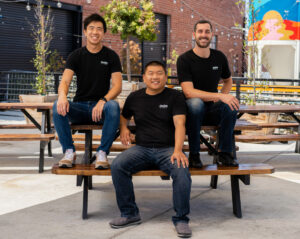A new food truck rolled onto the USC campus in October featuring pizza that is fresh, inexpensive and made by robots.
Hawthorne-based Stellar Pizza was founded in 2019 by former SpaceX engineers Benson Tsai, Brian Langone and James Wahawisan. Stellar Pizza’s food is made on the truck by robotic technology, and customers can watch their orders being prepared on a TV monitor. Saving costs on labor and real estate allows the company to keep prices low: $7.95 for a 12-inch cheese pizza. That pie would cost $14.99 at Dominoes.

Stellar Pizza currently operates at USC only, but has plans for a soft launch at UCLA. The company doesn’t intend to open a retail location. It still has human employees, usually two individuals per truck, who carry out tasks that the robots can’t, such as driving the truck, handing out the pizzas and answering questions customers may have about their food and its preparation.
“Any sort of new technology introduced is going to improve the efficiency of any business, it’s not unique to robotics,” Tsai said. “In the restaurant industry, specifically, I think ultimately what it’s going to allow restaurants to do is charge a lot less money. And I think that’s ultimately the primary goal.”
Utilizing tech
Automated technology in the food service industry is not new. A night out to eat nowadays often includes scanning a QR code to see a menu or closing out a check on a tablet with an electronic point-of-sales system. As many restaurants ride a razor-thin profit margin, they are looking for further ways to cut costs and automate service functions.
Salar Sheik, founder of restaurant consulting service Savory Hospitality Consulting, said robotics are the future for reducing labor costs. According to the National Restaurant Association, 62% of businesses recently polled reported being understaffed. The addition of technology, such as robots, into the kitchen can allow employees to focus on customer service and front-of-house duties.
Any sort of technology introduced is going to improve the efficiency
of any business.Benson Tsai
Stellar Pizza
“In general, hospitality is built off of people’s personalities,” Sheik said. “It’s sad, because you never want to replace chefs and line cooks, because they do, at the end of the day, build the restaurant’s morale. But in the back of the house, a lot of personality is not translated to (the) front of the house customer service aspect.”
Two big ways to cut labor costs in restaurants are to automate jobs or outsource them. Some businesses are already using the latter option. Freshii, a Canadian chain, was recently using virtual cashiers on tablets that offshored the work to an individual in Nicaragua, where the minimum wage is low. The current minimum wage in Los Angeles is $16.04 an hour, which will increase to $16.78 an hour in July.
Pasadena-based Miso Robotics has also introduced robotics to kitchens, letting restaurant owners replace their line cooks with a machine based around a robotic arm. The device is called Flippy and is marketed as “the world’s first autonomous robotic kitchen assistant.” Its functions include flipping burgers and frying food and, unlike a human employee, Flippy never has to take a meal break, won’t call in sick, and doesn’t need health benefits.
The newest Flippy model is available in a subscription-based contract that starts at $3,000 a month, according to Miso’s website. For comparison, the average monthly wage for a foodservice employee in Los Angeles was $2,952 in 2021. Those costs may appear close, but Flippy can work double shifts and doesn’t have to go through a training period. So far, Flippy has worked at Dodger Stadium and CaliBurger. Cali Group, the parent company of CaliBurger, owns Miso Robotics.

Labor woes
In 2021, nearly 79 out of every 1,000 jobs in Los Angeles were in the food service industry, a total of 448,780 jobs, according to the U.S. Bureau of Labor Statistics.
Many workers in the industry are what is referred to as new entrants, or individuals who have never held a job before. The pool of new entrant workers in food service may include people with felony convictions, minors and immigrants.
Sheik said that when food service jobs are automated, fewer employment options are left for such workers.

“Hospitality employs the largest amount of convicted felons,” Sheik said. “Hospitality doesn’t look at that. Hospitality just looks at your personality and where you are today. You have a smile on your face, you’re willing to work, we have a job for you. So it’s kind of scary to see robots being necessities. Where are those people going to find jobs now?”
The industry has faced a slew of economic stresses in recent years. With labor shortages continuing post-pandemic, recruitment and retention remain top concerns.
Automation and outsourcing of jobs have the ability to cut operational costs, though it may be expensive up front to implement such systems. While one way to fill workforce gaps is to implement technology, the National Restaurant Association said that 87% of businesses are expected to hire additional employees this year.
“I don’t think restaurant owners have a choice other than to adapt these robots into their kitchens,” Sheik said. “How long will it take is anyone’s guess; the cost is … still really expensive. But if you factor in, let’s say, a tenured robot, and a tenured employee, I’m guessing the cost might be more beneficial having a robot if you count in meal breaks and overtime.”
